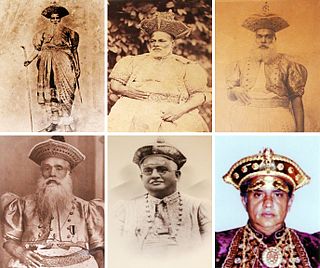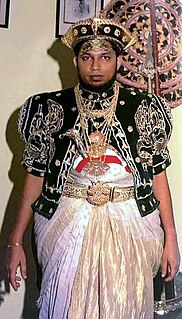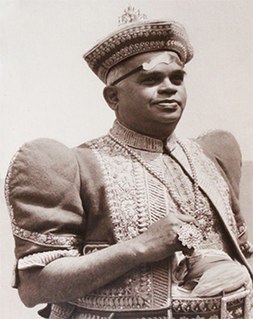
Kandy is a major city in Sri Lanka located in the Central Province. It was the last capital of the ancient kings' era of Sri Lanka. The city lies in the midst of hills in the Kandy plateau, which crosses an area of tropical plantations, mainly tea. Kandy is both an administrative and religious city and is also the capital of the Central Province. Kandy is the home of the Temple of the Tooth Relic, one of the most sacred places of worship in the Buddhist world. It was declared a world heritage site by UNESCO in 1988.

Sri Jayawardenepura Kotte, commonly known as Kotte, is the official administrative capital of Sri Lanka. Sri Jayawardenepura Kotte is a satellite city and located within the urban area of Sri Lanka's de facto economic and legislative capital, Colombo.

Kegalle is a large town in Sabaragamuwa Province of Sri Lanka. It is located on the Colombo–Kandy road, approximately 78 km (48 mi) from Colombo and 40 km (25 mi) from Kandy. It is the main town in the Kegalle District, which is one of two districts which comprise Sabaragamuwa Province. The town is governed by an Urban Council.

Gampaha is an urban city in Gampaha District, Western Province, Sri Lanka. It is situated to the north-east of the capital Colombo. It is the sixth largest urban area in Western Province, after Colombo, Negombo, Kalutara, Panadura and Avissawella. Gampaha is also the second largest municipal centre in Gampaha district, after Negombo. Gampaha has a land area of 25.8 ha and is home to the offices of 75 government institutions.

Kirindiwela is a town in the Western Province of Sri Lanka. It is the main administrative centre for the "Dompe" electorate in Gampaha district. The postal code of Kirindiwela is 11730.

The Kandy Esala Perahera also known as The Festival of the Tooth is a festival held in July and August in Kandy, Sri Lanka. This historical procession is held annually to pay homage to the Sacred Tooth Relic of Lord Buddha, which is housed at the Sri Dalada Maligawa in Kandy. A unique symbol of Sri Lanka, the procession consists of traditional local dances such as fire-dances, whip-dances, Kandyan dances and various other cultural dances, in addition to the elephants who are usually adorned with lavish garments. The festival ends with the traditional diya-kepeema ritual, a water cutting ceremony which is held at the Mahaweli River at Getambe, Kandy.
Govigama is a Sinhalese caste found in Sri Lanka. They form approximately half of the Sinhalesee poulation and are traditionally involved in agriculture. The term Govigama became popular during the last period of the Sinhalese Kingdom of Kandy. Its members have dominated and influenced national politics and Sinhalese Buddhism.

Kalutara or Kalutota is a major city in Kalutara District, Western Province, Sri Lanka. It is also the administrative capital of Kalutara District. It is located approximately 43 km (27 mi) south of the capital Colombo.The city holds a unique position for one of the four major rivers in Sri Lanka which joins the sea at the center of the city.The area is well known to produce the Mangosteens, a fruit introduced from Malaysia in the 19th century.

Wattala is a large suburb of Colombo city, in Western Province, Sri Lanka, situated around 9km from Colombo city centre. This suburb is situated on A3 highway from Colombo to Negombo. Around Wattala, there are many villages and towns.

Deshamanya Nissanka Parakrama Wijeyeratne, known as Nissanka Wijeyeratne, was a Sri Lankan politician, civil servant, diplomat and English language poet. He was also the Diyawadana Nilame of the Sri Dalada Maligawa, Kandy from 1975 to 1985. At the time of death he was serving as the chairman of The Law and Society Trust in Sri Lanka.

Diyawadana Nilame is the office of the chief lay custodian of Temple of the Tooth, Kandy, Sri Lanka. Formerly an office of the royal household, at present it is the trustee for the Temple of the Tooth as defined by the Buddhist Temporalities Ordinance of 1931. A ceremonial position, enriched with over two thousand years of history to safeguard and carry out ancient rituals for the relic of the tooth of the Buddha. The Diyawadana Nilame has the responsibility of overseeing of all aspects of the Sri Dalada Maligawa. He has the traditional duty of organizing the annual pageant, the Kandy Esala Perahera. The current Diyawadana Nilame is Pradeep Nilanga Dela.

Neranjan Priyadarshana Dullewe Wijeyeratne is a Sri Lankan. He was Diyawadana Nilame of the Sri Dalada Maligawa, Kandy for 20 years from 1985 to 2005. Wijeyeratne was former United National Party politician and ex chief organiser for the Galagedara Electorate in Kandy District and former Leader of the Opposition in the Kandy Municipal Council.

Sri Dalada Maligawa or the Temple of the Sacred Tooth Relic is a Buddhist temple in the city of Kandy, Sri Lanka. It is located in the royal palace complex of the former Kingdom of Kandy, which houses the relic of the tooth of the Buddha. Since ancient times, the relic has played an important role in local politics because it is believed that whoever holds the relic holds the governance of the country. Kandy was the last capital of the Sri Lankan kings and is a World Heritage Site mainly due to the temple.

Raja (1913 - 16 July 1988) was a Sri Lankan tusker elephant belonged to the Sri Dalada Maligawa, Kandy. Raja participated at the annual Esala procession in Kandy for around 50 years and was the sacred casket bearer of the final Randoli perehera for 37 years. He was one of the most celebrated elephants in Asia during his lifetime, and was world famous for his noble behavior. On 20 August 1986 former Sri Lankan President J. R. Jayewardene declared Raja as a national treasure, in recognition of his valuable services to the religion and culture of Sri Lanka.

General Anuruddha Leuke Ratwatte, frequently referred to as Anuruddha Ratwatte, was a Sri Lankan soldier and politician. He was a Cabinet Minister and Deputy Minister of Defence.
Barnes Ratwatte was a Ceylonese colonial-era legislator and a headman. He was a member of the State Council and the Senate of Ceylon. He was appointed to the posts of Rate Mahatmaya of Balangoda and Dissawa by the British. He was the father of Sirimavo Bandaranaike, the first female Prime Minister in the world.

Wijewardena Seneviratne Panditha Abeykoon Bandaranayake Wahala Mudiyanselage Harris Leuke Ratwatte was a Ceylonese legislator. He was a member of the State Council of Ceylon, Parliament and the Senate of Ceylon. Ratwatte was award the title of Dissawa by the British Governor of Ceylon and was elected as the Diyawadana Nilame of Sri Dalada Maligawa, Kandy.

The Bandaranaike family is a Sri Lankan family that is prominent in politics. Along with many members who have been successful politician across generations, the family includes three Prime Ministers and one President of Sri Lanka.
Asgiri Maha Viharaya is a Buddhist monastery located in Kandy, Sri Lanka. It is the headquarters of the Asgiriya chapter of Siyam Nikaya, one of the two Buddhist monasteries that holds the custodianship of sacred tooth relic of Lord Buddha kept in Sri Dalada Maligawa, Kandy. The chief incumbent of the Asgiri Maha Viharaya is the Mahanayaka thero of Asgiri chapter of Siyam nikaya, a leading Buddhist monastic fraternity in Sri Lanka. The present chief incumbent of Asgiri Maha Viharaya is Venerable Warakagoda Sri Gnanarathana Thero. Asgiri Maha Vihara traces its origin from the Wanavasi sect of the Dimbulagala forest monastery of Polonnaruva. Currently, 565 Buddhist temples in Sri Lanka function under Asgiri Viharaya of Kandy.

The History of the Kandyan Kingdom in Sri Lanka starts with its foundation in 1476.














